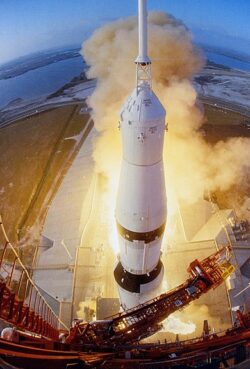
Mission Background
Apollo 6 was intended to send a CSM plus a Lunar Module Test Article (LTA), a simulated lunar module (LM) with mounted structural vibration sensors, into a translunar trajectory.
However, the Moon would not be in position for a translunar flight and the SM engine would be fired about five minutes later to slow the craft, dropping its apogee to 11,989 nautical miles (22,204 km) and causing the CSM to return to Earth, simulating a “direct-return” abort.
On the return leg, the engine would fire once more to accelerate the craft to simulate the nominal lunar return trajectory with a re-entry angle of −6.5 degrees and velocity of 36,500 feet per second (11,100 m/s). The entire mission would last about 10 hours.
This would test the Saturn V launch vehicle’s ability to send the entire Apollo craft to the Moon, and in particular test the stresses on the LM and the vibration modes of the entire Saturn V with near-full loads.
A full lunar mission spacecraft weight was not quite simulated because the LTA-2R weighed 26,000 pounds /12,000 kg. Also, the CSM was only fueled to a weight of 55,420 pounds /25,140 kg instead of the nominal lunar mission weight of 63,500 pounds /28,800 kg.
Vehicle Assembly
The S-IC first stage arrived by barge on March 13, 1967, and was erected in the VAB four days later, with the S-IVB third stage and Instrument Unit computer arriving the same day.
The S-II second stage was two months behind them and so was substituted with a dumbbell-shaped spacer so testing could proceed. This had the same height and mass as the S-II along with all the electrical connections. The S-II arrived May 24. It was stacked and mated into the rocket on July 7.
Testing was slow as the launch vehicle for Apollo 4 was still being checked, a limitation of the system where there wasn’t two of everyone and everything. The VAB could handle up to four Saturn Vs, but could only check out one at a time.
The CSM, a Block I model, similar to that flown on three previous uncrewed tests, arrived September 29 and was stacked December 10. It was actually a hybrid of two production spacecraft, consisting of CM-020 and SM-014, since SM-020 had been destroyed in a tank explosion and CM-014 had been dismantled to support the investigation into the Apollo 1 fire.
After two months of testing and repairs, the rocket was moved to the pad on February 6, 1968.
Launch
Apollo 6 was launched on April 4, 1968, but nlike the virtually perfect flight of Apollo 4, it experienced problems right from the start. Two minutes into the flight, the rocket experienced severe pogo oscillations for about 30 seconds. The cause was explained by George Mueller to a congressional hearing:
Pogo arises fundamentally because you have thrust fluctuations in the engines. Those are normal characteristics of engines. All engines have what you might call noise in their output because the combustion is not quite uniform, so you have this fluctuation in thrust of the first stage as a normal characteristic of all engine burning.
Now, in turn, the engine is fed through a pipe that takes the fuel out of the tanks and feeds it into the engine. That pipe’s length is something like an organ pipe so it has a certain resonance frequency of its own and it really turns out that it will oscillate just like an organ pipe does.
The structure of the vehicle is much like a tuning fork, so if you strike it right, it will oscillate up and down longitudinally. In a gross sense it is the interaction between the various frequencies that causes the vehicle to oscillate.
In part due to the vibrations, the spacecraft adapter that attached the CSM to the rocket and housed the mockup LM started to have some structural problems. Airborne cameras recorded several pieces falling off it at T+133 seconds.
After the first stage was jettisoned, the S-II second stage began to experience its own problems. Engine number two had performance problems from 225 seconds after liftoff, which abruptly worsened at T+319 seconds, and then at T+412 seconds the Instrument Unit shut it down altogether.
Then two seconds later, engine number three shut down as well. The Instrument Unit was able to compensate, and the remaining three engines burned for 58 seconds longer than normal. The S-IVB third stage also had to burn for 29 seconds longer than usual. The S-IVB also experienced a slight performance loss.
The S-IC first stage impacted the Atlantic Ocean east of Florida, while the S-II second stage impacted south of the Azores.
Orbit
Due to the less than nominal launch, the CSM and S-IVB were inserted into a 93.49-nautical-mile (173.14 km) by 194.44-nautical-mile (360.10 km) parking orbit, instead of the planned 100-nautical-mile (190 km) circular orbit.
Then, after the standard two parking orbits to check out the vehicle’s readiness for Trans Lunar Injection (TLI), the S-IVB failed to restart.
It was decided to use the SM engine to raise the spacecraft into a high orbit, as had been done in Apollo 4, in order to complete some of the mission objectives.
It burned for 442 seconds (longer than it would ever fire on a nominal lunar mission) to get to the planned 11,989-nautical-mile (22,204 km) apogee.
As there wasn’t enough fuel to speed up the atmospheric reentry, the spacecraft only entered the atmosphere at a speed of 33,000 feet per second (10,000 m/s) instead of the planned 37,000 feet per second (11,000 m/s) of a lunar return.
Ten hours after launch, it landed 43 nautical miles (80 km) from the planned touchdown point in the North Pacific Ocean north of Hawaii and was lifted on board the USS Okinawa.
The S-IVB’s orbit decayed three weeks later and it reentered the atmosphere on April 25, 1968.
Although Apollo 6 did not reach full translunar velocities in either direction, it was considered successful enough to fly astronauts on the next Saturn V, which in addition was tasked to send them to the Moon (lunar orbit) instead of the previously-planned Earth orbit for Apollo 8 the following December.


